Union Steam Ship Company,
the great RMS Aorangi (II) - WW2 Operations
Please
Note: Mobiles,
Firefox & Google Chrome other search engines may not suitable
Please
use Internet
Explorer or Old Google for this page to load perfectly!

Click
the logo above to reach the ssMaritime FrontPage for New Features & Updates
With
Reuben Goossens
Maritime Historian,
Author, Cruise‘n’Ship Reviewer and Maritime Lecturer
Please
Note: All ssMaritime and other related maritime
& cruise sites are 100% non-commercial and privately owned. Be assured that
I am NOT associated with any shipping or cruise companies or travel or cruise
agencies, etc! Although having been in the passenger shipping industry since 1960,
I am now retired but having completed features on well over 700 Classic Liners
and Cargo-Passengers Ships, I trust these will continue to provide you the
classic ship enthusiast the information you are seeking, but above all a great
deal of pleasure!
Union Steam
Ship Company
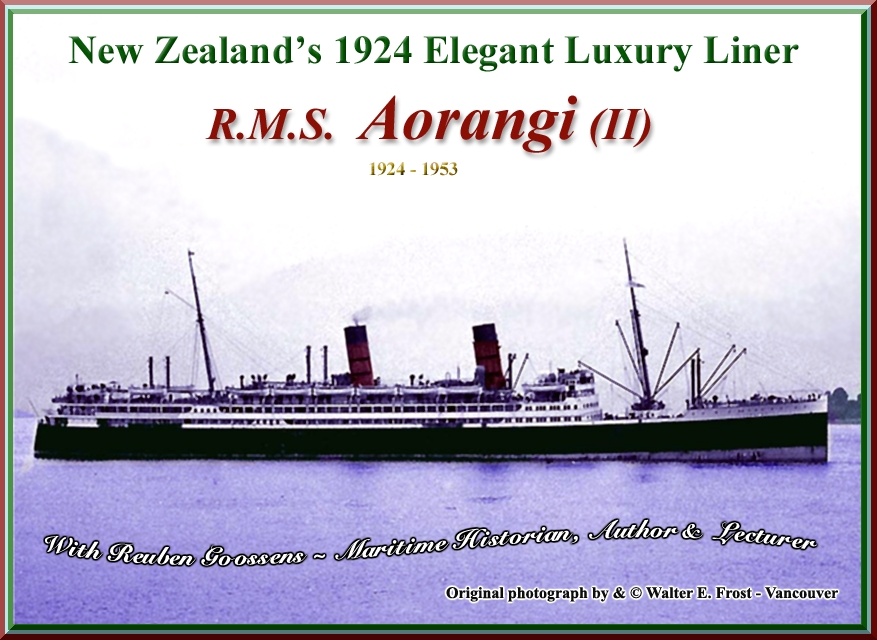
Introduction:
The
Union Steam Ship Company (USSCo) is a well established British/New Zealand
Shipping Company with a huge list of ships to its name, both cargo and
passenger liners. There were some very small ones in the early days, including
the combination sail and steamship the Aorangi,
built in 1983, but obtained by the USSCo in 1910. These were the early days of
a company that would go on and build wonderful and enduring ships such as the
7,527 GRT (Gross Registered Tons) as the SS Maunganui (1911-1948), which was
sold to a Greek company and was renamed Cyrenia (1948-1957), then came the
largest and the most glamorous to date, the luxurious 13,415 GRT SS Niagara
(1914-1940), followed by the remarkable but slightly smaller and enduring of
line 4,436 GRT SS Wahine (1913-1951).
However, it would not be until a good ten
years after the Wahine, in 1923 that the company laid plans for a brand new
much larger liner and gave the order for this ship to be built to Fairfield
Shipbuilding & Engineering Company in Glasgow, Scotland and soon
“Hull 603” commenced, she would become RMS Aorangi II.
I trust that you will enjoy this new feature,
which is one I am writing during my official retirement, when I should be
resting more. But, it is good to keep on doing something occasionally - Right?
But first, let us first look at the SS Aorangi 1.
Reuben Goossens.
**********************
S.S. Aorangi (II) WW2 Services:
Introduction:
RMS Aorangi was at first chartered in October,
1939 to transport troops from New Zealand to Fiji; thereafter, she began
transporting troops and airmen from Australia to Canada.
However, finally, the British Ministry of War Transport decided to officially
requisition her for war duties, and having been made ready, HMS Aorangi, now
officially a troopship, departed Sydney
for the United Kingdom,
under the command of Commander Ernest Colin Coats, DSO, DSC.
Please Note: I am delighted to provide information of the Aorangi’s
service records and convoy’s and voyages, however, not every single
voyage is recorded, but I will provide as much as is available!
Although RMS Aorangi’s services were far
away from the conflicts in Europe, however there remained a danger off the
coasts of Australia
and New Zealand.
In fact, the USSCo 13,415 GRT, RMS Niagara, also on the Trans-Pacific, Sydney to Vancouver service, tragically was an early
casualty of WW2, when she struck a mine during the early hours of June 19, 1940
having just departed Auckland.
The mine was part of a many laid by the German auxiliary cruiser the Orion. The
Niagara
sank off ‘Bream Head,’ near Whangarei in 360 feet of water. All 349
passengers and crew were rescued because the ship thankfully sank slowly in
calm seas, allowing for an orderly evacuation of the once popular passenger
Liner.
However, sunk with the ship was a fortune of
590 bars of gold (around eight tons), which was in transit from New Zealand to
Canada representing payment to the United States from the Bank of England for
munitions. Salvage operations on the Niagara commenced rapidly by the United
Property Salvage Ltd,’ of Melbourne,
but it took a good six weeks to locate the wreck of the ship. At that time only
555 gold bars were recovered, however in 1953 a further 30 bars were salvaged,
yet five remained unaccounted for.
Late in 1939 the Aorangi departed with troops
from New Zealand
to Fiji.
Until the first half of 1941, her operations was based
under a charter agreement, moving troops and airmen from Australia to Canada,
etc.
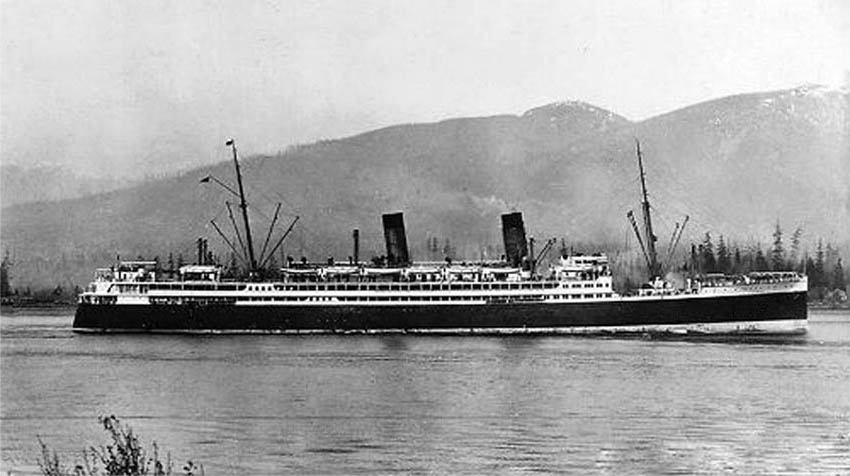
HMS
Aorangi is seen whilst still under charter transporting servicemen, etc
HMS Aorangi the Troopship:
Then mid 1941 the RMS Aorangi was officially
requisitioned by the ‘British Ministry of War Transport’ and sailed
from Sydney to
the United Kingdom
to be converted into a troopship. Having been converted to enter troop ship
service, she would operate with convoys transporting troops and supplies to the
Near East, Middle East and India and bringing American
and Canadian troops to Europe.
The Aorangi
was now classified as a ‘Defensively Equipped Merchant Ship’
(DEMS). Equipment fitted for this role included degaussing gear and a variety
of armament including a rear gun emplacement fitted with one 4.7-inch gun, a
3-inch high angle and two 20-mm Oerlikon pom-poms just
forward of it. Two further Oerlikons were located amidships, as well as two
5-inch Brownings on the Bridge, and two more Oerlikons were located on the
forecastle.
The HMS Aorangi departed the United Kingdom on
November 13, 1941 as part of convoy WS 12Z and sailed via the Suez Canal to
Freetown, arriving there on November 25, 1941 and departed three days later.
She then refuelled in Durban,
departing there on December 24, 1941. The Aorangi, was transporting 2,200
troops, from the 53rd Infantry Brigade, 232 Squadron RAF, 6th Heavy & 35th
Light Artillery Regiments RA, and 85th Anti-Tank Regiment RA., and there were
three other ships in convoy DM1 as they headed for Singapore there they
required urgent additions of numbers for the forces there. Aorangi arrived in Singapore
on January 13, 1942.
HMS Aorangi departed Singapore filled with
evacuated civilians from Singapore, departing January 16, 1942 and she headed
for the port of Fremantle (Perth – Western Australia) arriving there on
January 24.
Later, the Aorangi departed the United Kingdom as part of
convoy WS 18 on April 15, 1942 and again headed for Freetown,
where she arrived on April 29. She departed again on May 3, with the convoy and
arrived off Cape Town on May 15,
1942. Although the Aorangi was due to refuel at Durban,
but a minefield was recently laid by the raider ‘Doggerbank,’ and
two other sadly ships sadly the mines. After unloading her troops, the Aorangi set sail together with two other
ships and headed for the River Plate.
A very heavily protected convoy AT 17 departed
New York
bound for the Clyde on July 1, 1942 and there were with eight ships in this
convoy including the Aorangi.
However at some time, the Aorangi & Siboney were separated from the main
convoy and therefore they headed for Halifax.
Both ships departed from Halifax
on July 5, as convoy AT 17B and reached the Clyde on July 12.
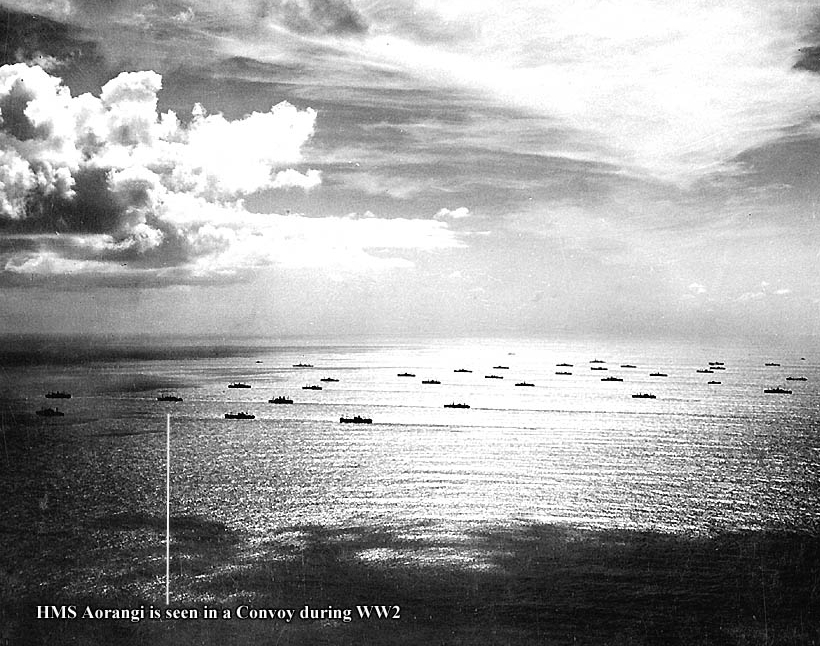
The Aorangi sailed from the Clyde again on July 29, 1942 as part of
convoy WS 21, this convoy was the Sulzer powered Rangitiki. Freetown was reached on August 10, the convoy
departed five days later, and they arrived at Cape Town
on August 27. The Aorangi
refuelled here, and her departure was on August 30, 1942. However on September
10, the convoy split as they normally would in the Indian Ocean, with the
Aorangi bound for Aden
and Suez, arriving later
in September 1942.
A small convoy WS 29A with just two ships, one
of these being the Aorangi departed from the United Kingdom on April 20, 1943
and headed for Casablanca, Dakar and then Freetown arriving there on May 4,
1943. Here a number of other ships joined the convoy now identified as WS 29.
Next port of call was Cape Town,
which the convoy reached on May 18. However, the Aorangi was in another part of
the group that went through to Durban
to bunker (refuel), arriving there on May 20.
We next see the Aorangi in convoy KMF 25A which had a good
twenty-six, mostly large troop ships. This convoy departed from Liverpool on
October 27, 1943 and was bound for Alexandria,
where they arrived on November 11. However, as it does happen in convoys, the
Aorangi only went as far as Oran
in Algeria
on this voyage.
The next convoy MKF 26 departed Port Said on November 17, with the Aorangi
joining the convoy at Oran
on November 30, and they headed for the United Kingdom, reaching
the Clyde
on December 8.
Her last official trooping voyage was early in
1944, being a round trip from the UK to Malta.
The HMS Aorangi departed the Clyde on February 21, 1944 sailing as always in
convoy, but number KMF 29, she had 1,551 servicemen aboard and headed for Alexandria.
She next sailed in convoy MKF 29, from Port
Said Egypt on March 2, bound for
Liverpool via Malta.
HMS Aorangi departed Malta
with 3,143 troops aboard bound for Liverpool
and she arrived there on March 16, 1944.
She had now completed her duties as a
troopship, and was about to enter another role, thus she entered a dockyard in Liverpool several days after her arrival for
conversion.
D-Day Depot Ship:
In May 1944 the HMS Aorangi was fitted out as
an accommodation and depot ship for small craft personnel, as well as having
hospital facilities. During the Normandy invasion she served as a depot ship
for a fleet of 150 tugs and auxiliary ships, and for other vessels involved
with towing the artificial “Mulberry harbours” across the Channel
providing food, water, ammunition, engine part’s and relief crews. From
D-Day (June 6, 1944) until the end of July, the Aorangi serviced 1,200 vessels and countless
other small craft. Her hospital took in wounded men from the beachheads. Not
far away at the D-Day landings the HMT Monowai was used in the transport of
troops across the English Channel.
During her time on Operation Neptune Aorangi provided services to 1,200
vessels, and the hospital looked after hundreds of wounded men brought back
from the landing beaches. She left Liverpool on April 29th 1944 and arrived at
an anchorage off Lee-on- Solent
on May 5. The Solent, off the town of Lee-on-Solent,
was the marshalling area for the tugs. The Solent was extremely crowded
waterway by the end of May, and many of the tugs were dispersed; Later the
Aorangi was moved to Southampton
where she remained in this role until she was relieved in the second week of
July 1944 by the destroyer depot ship Empress of Russia. She next returned to
the Clyde,
where she arrived on July 13, 1944.
Depot & Crew
Accommodation Ship:
On July 25, the Aorangi entered the Fairfield
Shipbuilding yards in Glasgow,
for further conversion work to equip her as a submarine depot and crew
accommodation ship. It was intended that she operate her as a depot ship for
the 8 ‘T’ Class and 2 ‘S’ Class Boats of the
reconstituted 4th Submarine Flotilla at Trincomalee in East Ceylon. When
completed, the HMS Aorangi was to leave the UK in February 1945;
however her departure to the Far
East was delayed to March 31, 1945. Thus she departed
the Clyde on March 31, 1944 in convoy KMF.42 bound for Trincomalee via Bombay
with 433 service passengers onboard. She continued operations in Ceylon in addition she was
also sent to Fremantle, Western Australia until May
1945.
She was then
reallocated to the ‘British Pacific Fleet’ in July 1945 having been reassigned as a ‘Submarine Spare Crew
Accommodation Ship’ and departed to join the Fleet Train at Manus in the Admiralty Islands.
Flagship of the Commodore
Fleet:
On her arrival at Manus on July 15, 1945 she
was taken in hand by the Heavy Repair Ship HMS Artifex and further converted to
become the flagship of ‘Commodore Fleet,’ this necessitated the
creation of new offices, supplying additional telephones and furniture, etc.
She was also fitted out as a Fleet Chart Depot and a Fleet Medical
Store-Issuing Depot.
Post War:
After the Japanese surrender, the Aorangi remained
at Hong Kong
as an accommodation ship for men released from war service and waiting to go
home. It was estimated that during the WW2, Aorangi bravely transported 36,000 troops and
evacuated 5,500 refugees from war zones.
Then on Tuesday September 25, 1945 the HMS
Aorangi arrived in Brisbane, Queensland Australia,
with 700 former Australian prisoners of war. In Brisbane, one hundred men departed the ship and
the Aorangi left Brisbane
on Thursday September 27, and headed for Sydney
arriving there on Saturday September 29, 1945 with the remaining 600 men.
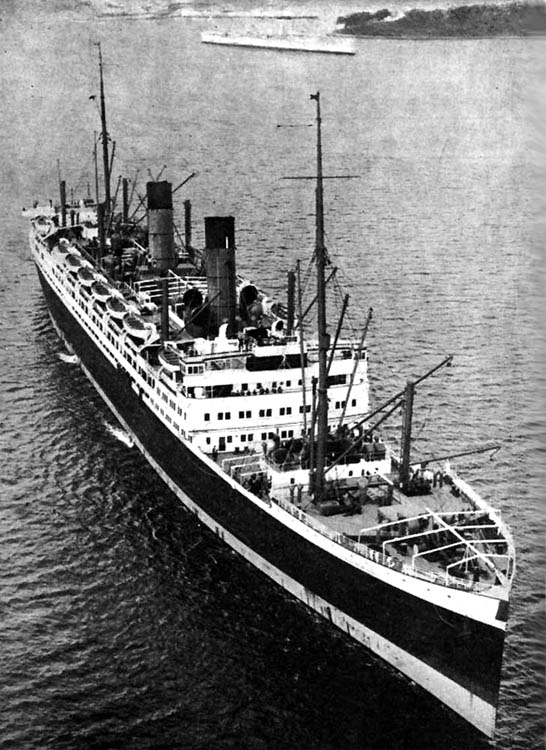
The HMS
Aorangi is seen in Sydney
Harbour
with Warships in the background
Sadly the seven hundred returned to Australia on the Aorangi
was but a very small number of the recently freed Australian and New Zealand
prisoners of war that were yet to be recovered from territories formerly
controlled by the Japanese, but those who survived all did eventually come
home!
Below a Brave Service Record of the HMS Aorangi
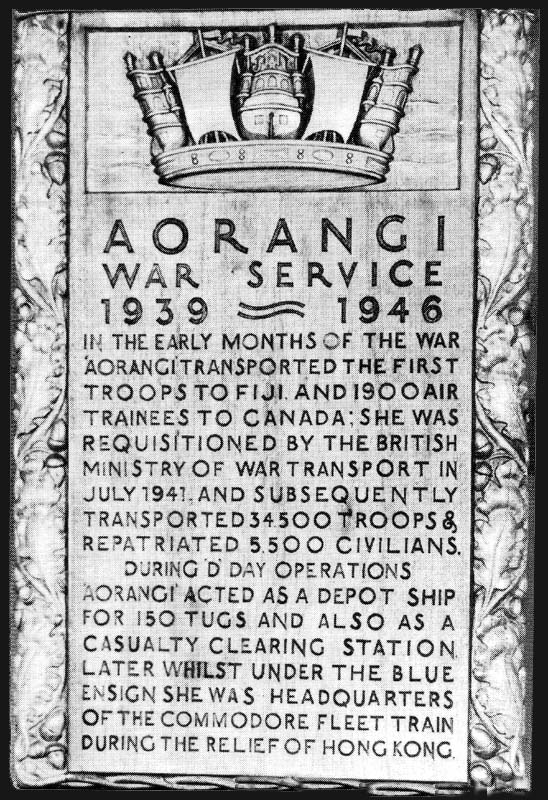
Please Note: RMS Aorangi’s restoration into a Passenger Liner and return
to her Sydney
to Vancouver service, as
well as her final years are fully covered on Page One.
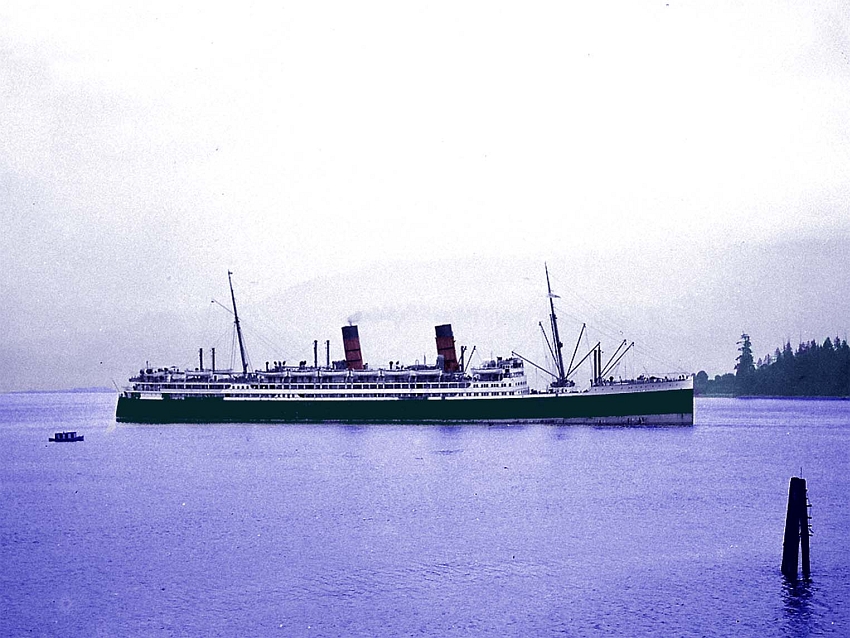
HMS
Aorangi is seen back in civil service in 1950
Return to RMS Aorangi Page One
Also view the other USSCo Passenger Ships online, from
oldest to the last ever built
SS Waitaki / SS
Moeraki & Manuka / SS Marama & Maheno
TSS Monowai / TSS Awatea / MV Matua
& MV Tofua
**********************
Use
the Back button on your browser or Close the Page to return to the previous
page
or go to our INDEX
ssMaritime.com & ssMaritime.net
Where
the ships of the past make history & the 1914 built MV Doulos Story
Photographs on ssmaritime and associate pages
are by the author or from the author’s private collection. In addition
there are some images that have been provided by Shipping Companies and private
photographers or collectors. Credit is given to all contributors. However,
there are some photographs provided to me without details regarding the
photographer/owner concerned. I hereby invite if owners of these images would
be so kind to make them-selves known to me (my email address may be found on www.ssmaritime.com only), in order that due
credit may be given.
This notice covers all pages, although, and I
have done my best to ensure that all photographs are duly credited and that
this notice is displaced on each page, that is, when a page is updated!
ssMaritime is owned and © Copyright
by Reuben Goossens - All Rights Reserved






